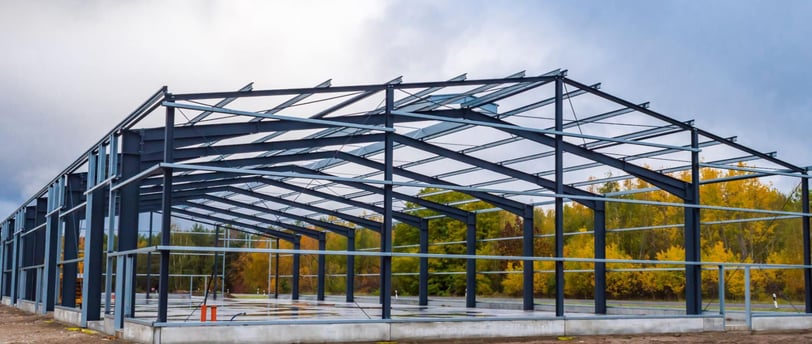Why Metal Buildings are Revolutionizing American Business
Why Modular Steel Panel Buildings are Revolutionizing American Business
Derek Vest Fort Myers
8/4/20243 min read


The Structural Edge: Why Metal Buildings are Revolutionizing American Business
Introduction
In the evolving landscape of American construction, metal buildings are gaining momentum as a preferred choice over traditional materials such as wood and concrete. Their increasing popularity is attributed to their durability, echo-friendliness, and versatility. This article explores the key advantages of metal buildings, highlighting why they are becoming the top choice for a variety of structures, including commercial spaces, warehouses, homes, and agricultural facilities. We’ll delve into their adaptability, energy efficiency, and ease of assembly, emphasizing how metal buildings represent a practical and forward-thinking option in an era that values sustainable and efficient building solutions.
The Multifaceted Benefits of Metal Buildings
Durability and Longevity
Metal buildings are celebrated for their outstanding durability and long lifespan. Unlike traditional materials, metal is highly resistant to common issues such as termite damage, which frequently affects wooden structures and can lead to costly repairs. Metal structures also resist mold growth, contributing to their longevity and ensuring a healthier indoor environment. Additionally, metal’s high melting point enhances fire resistance, significantly lowering the risk of fire damage compared to other materials. This combination of termite, mold, and fire resistance means that metal buildings require minimal maintenance, preserving their structural integrity and appearance for decades. This makes them an ideal choice for those seeking a long-term, reliable building solution.
Architectural Flexibility
Metal buildings are renowned for their architectural versatility, accommodating a wide range of design preferences from classic to contemporary industrial styles. This flexibility is particularly beneficial for businesses that want to create spaces that reflect their brand identity or operational needs. Whether aiming for a traditional, elegant façade or a sleek, modern look, metal structures can be easily customized. The adaptability of metal allows for diverse roof lines, unique textures, and an extensive palette of colors, enabling businesses to design visually appealing and functional spaces. This design flexibility not only meets various aesthetic preferences but also supports practical business operations.
Environmental Sustainability
In today’s co-conscious world, metal buildings stand out for their environmental sustainability. One of their key econ-friendly attributes is energy efficiency; metal reflects solar heat, which helps lower cooling costs and can be effectively insulated to reduce heating expenses. Moreover, metal is highly recyclable, with most components being recyclable at the end of their life cycle, which significantly lessens environmental impact. During construction, metal buildings generate less waste compared to traditional methods, as components are per-engineered and cut to precise measurements. This efficient construction process minimizes waste and reduces the overall carbon footprint, underscoring metal buildings’ role in promoting sustainable and environmentally responsible construction practices.
Why Metal Buildings Are Essential for American Businesses
Customizable Solutions for Diverse Industries
Metal buildings have become integral to the American business landscape due to their exceptional customization, catering to various industries with unique needs. In agriculture, metal structures provide spacious environments for storing machinery and crops, with the advantage of being easily expandable as operations grow. Retail businesses benefit from metal’s adaptability; these buildings can be designed with large, attractive storefronts and flexible interior layouts that can evolve with the business. For manufacturing, metal buildings offer the strength to support heavy machinery and withstand the demands of industrial processes, with customizable features like reinforced floors, high ceilings, and large door openings for ease of access.
Boosting the Domestic Economy
The construction of metal buildings significantly supports the American economy. It bolsters the domestic steel industry by driving demand and fostering growth within this critical sector. Additionally, the development and assembly of metal structures create jobs across various fields, from manufacturing to on-site construction. This not only enhances employment rates but also contributes to broader economic growth.
Regulatory Compliance and Safety Standards
Metal buildings are well-regarded for their adherence to stringent American safety and building regulations, ensuring high levels of safety and quality. They meet rigorous standards for fire resistance, seismic performance, and wind load capacity, providing business owners with confidence in their investment’s safety and durability. Compliance with national safety codes also simplifies the permitting process, offering a streamlined path for businesses to develop and expand.
The Inherent Advantages of Metal as a Building Material
Superior Structural Integrity
Metal offers an exceptional strength-to-weight ratio, which is a fundamental advantage in construction. This means metal structures can support substantial weights and pressures while using less material compared to other building types. This strength is especially beneficial in areas prone to environmental stressors like high winds, heavy snow, or seismic activity, ensuring safety and stability and reducing the likelihood of structural damage.
Innovative Designs and Applications
The use of metal in construction has led to innovative architectural designs and applications. For instance, repurposing steel shipping containers into homes, offices, and retail spaces offers a cost-effective and sustainable solution. Similarly, metal frameworks are essential in constructing skyscrapers, enabling designs that combine height with stability and aesthetic appeal.
Long-Term Financial Benefits
Metal buildings offer significant long-term financial benefits. Their durability results in lower maintenance and repair costs compared to traditional materials. Metal’s resistance to water and pests also leads to reduced insurance premiums. Furthermore, the energy-efficient properties of metal buildings often result in lower operational costs, making them a financially wise choice over time.
All Rights Reserved: 2021-2024
Offices: Tampa - Istanbul - Hong Kong
